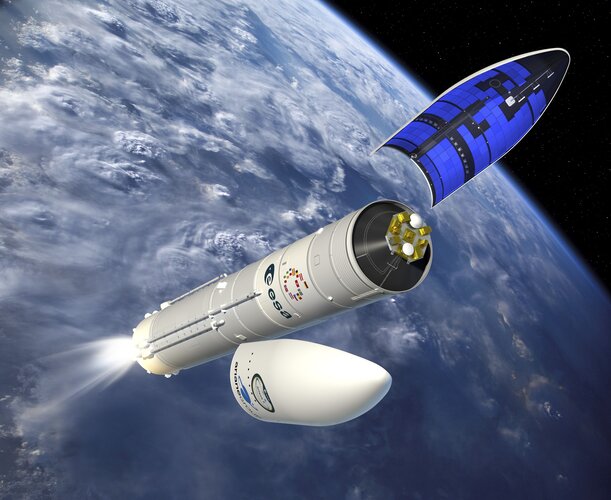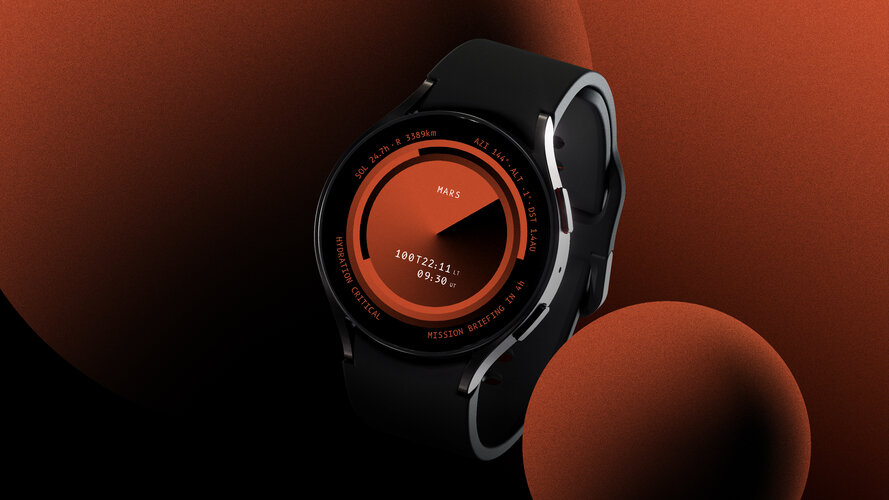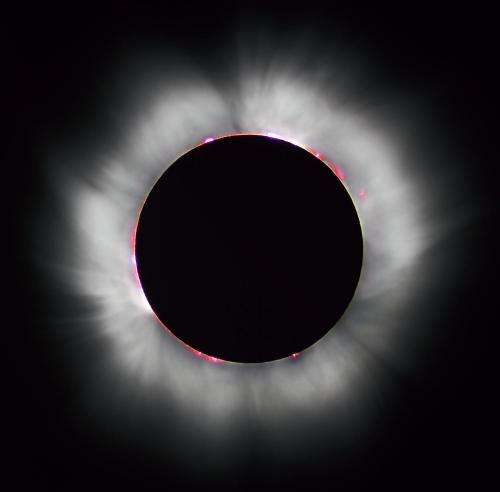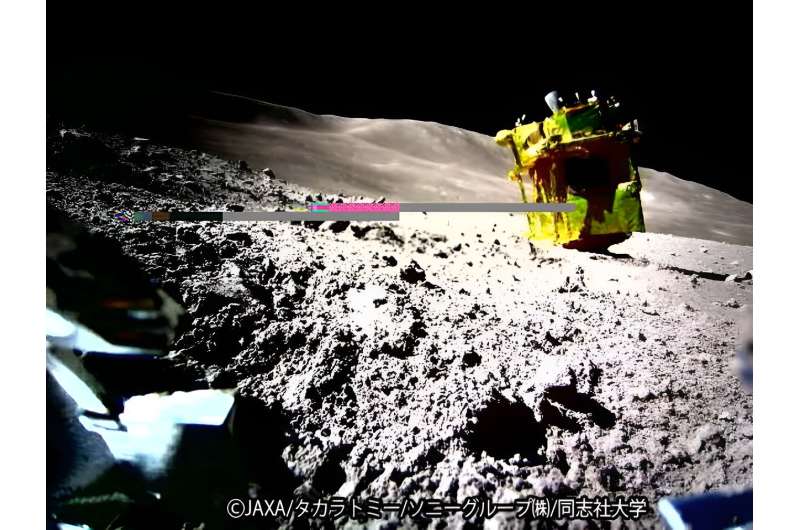Proba-3 Media Kit
Thursday, 28 March 2024 13:43
Proba-3 Media Kit
Info for media on ESA's precision formation flying mission
Ariane 6 Fairing Separation
Thursday, 28 March 2024 13:35 Image:
Image:
Artist's view of the Ariane 6 rocket on it’s first flight as its fairing – a nose cone that splits into two vertically – showing its passengers at the top of the launcher. The view shows Ariane 6 already three minutes into launch after Ariane 6 will have jettisoned its two boosters after liftoff from Europe's Spaceport in Kourou, French Guiana.
The passengers Ariane 6 will launch into space on its inaugural flight include several satellites, deployers and experiments from space agencies, companies, research institutes, universities and young professionals on its first flight.
From established players like NASA to students designing their first ever
JAXA selects Interstellar Technologies as priority launch provider
Thursday, 28 March 2024 13:01

China adds new moon base project partners, but struggles to attract national-level participation
Thursday, 28 March 2024 08:59

Time to see the bigger picture
Thursday, 28 March 2024 08:45
ESA has teamed up with Samsung to launch the first watch face for our Solar System.
ESA and NASA team up to study solar wind
Thursday, 28 March 2024 08:00
In the run up to April’s total solar eclipse, ESA-led Solar Orbiter and NASA-led Parker Solar Probe are both at their closest approach to the Sun. Tomorrow, they are taking the opportunity to join hands in studying the driving rain of plasma that streams from the Sun, fills the Solar System, and causes dazzlement and destruction at Earth.
Schools in the path of April's total solar eclipse prepare for a natural teaching moment
Thursday, 28 March 2024 07:25
Seventh-grade student Henry Cohen bounced side to side in time to the Beatles' "Here Comes the Sun" playing in teacher Nancy Morris' classroom, swinging his arms open and closed across the planets pictured on his T-shirt.
Henry and other classmates at Cleveland's Riverside School were on their feet, dancing during a session of activities tied to April's total solar eclipse. Second-graders invited in for the lessons sat cross-legged on the floor, laughing as they modeled newly decorated eclipse viewing glasses. Dioramas with softball-sized model earths and moons and flashlight "suns" occupied desks and shelves around the room.
Henry said his shirt reflected his love of space, which he called "a cool mystery." The eclipse, he said, "is a one in a million chance and I'm glad I get to be here for it."
For schools in or near the path of totality of the April 8 eclipse, the event has inspired lessons in science, literacy and culture. Some schools also are organizing group viewings for students to experience the awe of daytime darkness and learn about the astronomy behind it together.
Japan moon probe survives second lunar night
Thursday, 28 March 2024 07:21
Japan's moon lander woke up after unexpectedly surviving a second frigid, two-week lunar night and transmitted new images back to Earth, the country's space agency said Thursday.
The unmanned Smart Lander for Investigating Moon (SLIM) probe touched down in January, making Japan only the fifth nation to reach the lunar surface without crashing.
But the lightweight spacecraft landed at a wonky angle that left its solar panels facing the wrong way.
The Japan Aerospace Exploration Agency announced the probe's latest surprise awakening in a post on X, formerly Twitter.
"We received a response from SLIM last night and confirmed that SLIM had successfully completed its second overnight," it said.
A black-and-white photo of the rocky surface of a crater accompanied the post on SLIM's official account.
Orbex patents Reusable Rocket Technology dubbed 'Petal Fold'
Wednesday, 27 March 2024 22:08 Orbex has achieved a significant milestone in the advancement of space technology by securing a patent for its innovative REFLIGHT reusable rocket technology. The European Patent Office and the United States have both granted patents for this cutting-edge technology, marking a major leap forward in sustainable space exploration.
Designed specifically for micro-launcher rockets, such as Orb
Orbex has achieved a significant milestone in the advancement of space technology by securing a patent for its innovative REFLIGHT reusable rocket technology. The European Patent Office and the United States have both granted patents for this cutting-edge technology, marking a major leap forward in sustainable space exploration.
Designed specifically for micro-launcher rockets, such as Orb End of an Era: Final Delta IV Heavy Rocket Carries NROL-70 on Historic Mission
Wednesday, 27 March 2024 20:44 The last mission of the venerable Delta IV Heavy rocket, marked by the launch of the NROL-70 security payload, is scheduled for March 28, 2024, at 1:40 PM EDT from SLC 37, Cape Canaveral Space Force Station. This event not only signifies the conclusion of the Delta Rocket lineage but also celebrates its rich history of achievements and innovations in space exploration.
The Delta Rocket ser
The last mission of the venerable Delta IV Heavy rocket, marked by the launch of the NROL-70 security payload, is scheduled for March 28, 2024, at 1:40 PM EDT from SLC 37, Cape Canaveral Space Force Station. This event not only signifies the conclusion of the Delta Rocket lineage but also celebrates its rich history of achievements and innovations in space exploration.
The Delta Rocket ser ESA targets Enceladus in ambitious mission to Saturn
Wednesday, 27 March 2024 20:44 The European Space Agency (ESA) has unveiled plans for an ambitious mission to explore Enceladus, one of Saturn's moons, as part of its Voyage 2050 program. This initiative, which follows in the footsteps of previous missions like Juice, LISA, and NewAthena, aims to investigate the habitability of ocean worlds within our Solar System. Enceladus, with its subsurface ocean, geysers of water vapor,
The European Space Agency (ESA) has unveiled plans for an ambitious mission to explore Enceladus, one of Saturn's moons, as part of its Voyage 2050 program. This initiative, which follows in the footsteps of previous missions like Juice, LISA, and NewAthena, aims to investigate the habitability of ocean worlds within our Solar System. Enceladus, with its subsurface ocean, geysers of water vapor, France's Pioneering Role in Strengthening European Space Security
Wednesday, 27 March 2024 20:44 In the recent decade, the international landscape of space has undergone significant transformations with over 90 countries participating, commercial firms launching satellites regularly, and at least 12 nations establishing military space organizations. Amidst this global evolution, European countries, led by France, have intensified their focus on space security, aligning with their national s
In the recent decade, the international landscape of space has undergone significant transformations with over 90 countries participating, commercial firms launching satellites regularly, and at least 12 nations establishing military space organizations. Amidst this global evolution, European countries, led by France, have intensified their focus on space security, aligning with their national s GMV Spearheads ESA's Mission to Revolutionize Satellite Navigation with LEO Technology
Wednesday, 27 March 2024 20:44 In a significant advancement for satellite navigation technology, the European Space Agency (ESA) has selected GMV, a global technology firm, for a pioneering mission. This 78.4 million euro project aims to demonstrate the potential of Low-Earth Orbit (LEO) satellites for enhancing Positioning, Navigation, and Timing (PNT) services. Traditionally, satellite navigation systems have depended on Me
In a significant advancement for satellite navigation technology, the European Space Agency (ESA) has selected GMV, a global technology firm, for a pioneering mission. This 78.4 million euro project aims to demonstrate the potential of Low-Earth Orbit (LEO) satellites for enhancing Positioning, Navigation, and Timing (PNT) services. Traditionally, satellite navigation systems have depended on Me 




